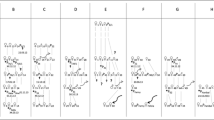Abstract
Field observations on 117 tree shrews (Tupaia glis) were conducted over a period of six months in Singapore. Of 19 groups (pairs or harems, with or without offspring), nine changed their composition mainly through the disappearance of juveniles. Juvenile males tended to disappear earlier than juvenile females. The areas used by the groups remained stable throughout their disappearance and membership changes. The onset of mating was observed in December, and the synchronous disappearance of offspring of the preceding reproduction typically occurred in late January. However, in one group, two litters coexisted. Offspring were usually excluded from their group presumably by the adult member of the same sex. Males disappeared at the timing of oestrus in their mothers, while females probably disappeared during the later stages of pregnancy of their mothers.
Similar content being viewed by others
References
Bearder, S. K. &R. D. Martin, 1979. The social organization of a nocturnal primate revealed by radio tracking. In:A Handbook on Biotelemetry and Radio Tracking,C. J. Amlaner,Jr. &D. W. MacDonald (eds.), Pergamon Press, Oxford & New York, pp. 633–648.
Charles-Dominique, P., 1974. Aggression and territoriality in nocturnal prosimians. In:Primate Aggression, Territoriality, and Xenophobia,R. L. Holloway (ed.), Academic Press, New York, pp. 31–49.
————, 1977.Ecology and Behaviour of Nocturnal Primates. Gerald Duckworth, London.
———— &C. M. Hladik, 1971. Le Lépilémur du Sud de Madagascar: écologie, alimentation et vie sociale.La Terre et la Vie, 25: 3–66.
Clark, A. B., 1978. Sex ratio and local resource competition in a prosimian primate.Science, 201: 163–165.
Doyle, G. A. &R. D. Martin (eds.), 1979.The Study of Prosimian Behavior. Academic Press, New York.
D'Souza, F., 1974. A preliminary field report on the lesser tree shrewTupaia minor. In:Prosimian Biology,R. D. Martin,G. A. Doyle &A. C. Walker (eds.), Gerald Duckworth, London, pp. 167–182.
Fogden, M., 1974. A preliminary field-study of the western tarsier,Tarsius bancanus Horsefield. In:Prosimian Biology,R. D. Martin,G. A. Doyle &A. C. Walker (eds.), Gerald Duckworth, London, pp. 151–165.
Harrison, J. L., 1955. Data on the reproduction of some Malayan mammals.Proc. Zool. Soc. Lond., 125: 445–460.
Hasler, J. F. &M. W. Sorenson, 1974. Behavior of the tree shrew,Tupaia chinensis, in captivity.Amer. Midl. Nat., 91: 294–314.
Hendrickson, J. R., 1954. Breeding of the tree shrew.Nature, 174: 794–795.
Jolly, A., 1966.Lemur Behavior. Univ. of Chicago Press, Chicago.
Kaufmann, J. H., 1965. Studies on the behavior of captive tree shrews (Tupaia glis).Folia Primatol., 3: 50–74.
Kawamichi, T., 1970. Social pattern of the Japanese pika,Ochotona hyperborea yesoensis, preliminary report.J. Fac. Sci. Hokkaido Univ., Ser. VI, Zool., 17: 462–473.
————, &M. Kawamichi, 1978. Hair clipping patterns for marking tree shrew and chipmunk.Jap. J. Ecol., 28: 65–67.
————, &M. Kawamichi, 1979. Spatial organization and territory of tree shrews (Tupaia glis).Anim. Behav., 27: 381–393.
Lack, D., 1968.Ecological Adaptations for Breeding in Birds. Methuen & Co. Ltd., London.
Martin, R. D., 1968. Reproduction and ontogeny in tree-shrews (Tupaia belangeri), with reference to their general behaviour and taxonomic relationships.Zeit. f. Tierpsychol., 25: 409–495, 505–532.
————,G. A. Doyle &A. C. Walker (eds.), 1974.Prosimian Biology. Gerald Duckworth, London.
Morris, J. H., N. C. Negus &R. O. Spertzel, 1967. Colonization of the tree shrew (Tupaia glis).Lab. Anim. Care, 17: 514–520.
Niemitz, C., 1979. Outline of the behavior ofTarsius bancanus. In:The Study of Prosimian Behavior,G. A. Doyle &R. D. Martin (eds.), Academic Press, New York, pp. 631–660.
Nieuwolt, S., 1973. Climate. In:Animal Life and Nature in Singapore,S. H. Chuang (eds.), Singapore Univ. Press, Singapore, pp. 27–39.
Richarz, K., 1979. Mechanismen der Gruppenbildung und -bindung beiTupaia glis Diard, 1820.Anthrop. Anz., 37: 141–176.
————, 1980. Mechanismen zur Inzestvermeidung beiTupaia glis Diard, 1820.Anthrop. Anz., 38: 286–296.
Schwaier, A., 1975. The breeding stock of Tupaias at the Battelle-Institut.Lab. Anim. Handb., 6: 141–149.
Shimada, A., 1973. Studies onTupaia glis Diard as an experimental animal: its breeding and growth.Exp. Anim., 22 (Suppl.): 351–357.
Sorenson, M. W., 1970. Behavior of tree shrews. In:Primate Behavior, Vol. 1,L. A. Rosenblum (ed.), Academic Press, New York, pp. 141–193.
———— &C. H. Conaway, 1966. Observations on the social behavior of tree shrews in captivity.Folia Primatol., 4: 124–145.
Sprankel, H., 1959. Fortpflanzung vonTupaia glis Diard 1820 (Tupaiidae, Prosimiae) in Gefangenschaft.Naturwiss., 46: 338.
————, 1960. Zucht vonTupaia glis Diard 1820 (Tupaiidae, Prosimiae) in Gefangenschaft.Naturwiss., 47: 213.
Tattersall, I. &R. W. Sussman (eds.), 1975.Lemur Biology. Plenum Press, New York.
Vandenbergh, J. G., 1963. Feeding, activity and social behavior of the tree shrew,Tupaia glis, in a large outdoor enclosure.Folia Primatol., 1: 199–207.
Wade, P., 1958. Breeding season among mammals in the lowland rain-forest of north Borneo.J. Mamm., 39: 429–433.
Author information
Authors and Affiliations
About this article
Cite this article
Kawamichi, T., Kawamichi, M. Social system and independence of offspring in tree shrews. Primates 23, 189–205 (1982). https://doi.org/10.1007/BF02381160
Received:
Accepted:
Issue Date:
DOI: https://doi.org/10.1007/BF02381160




